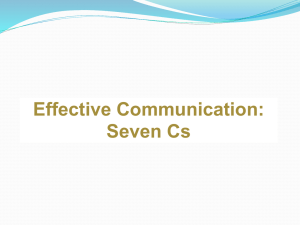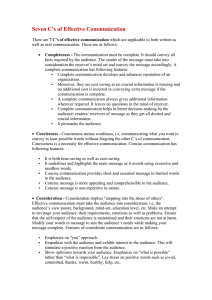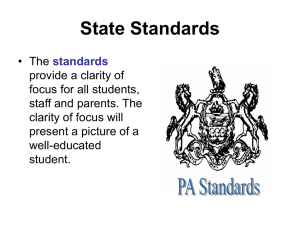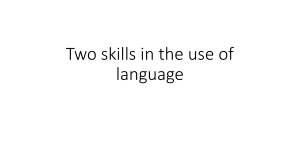Effective Communication: Completeness, Conciseness, Consideration
advertisement
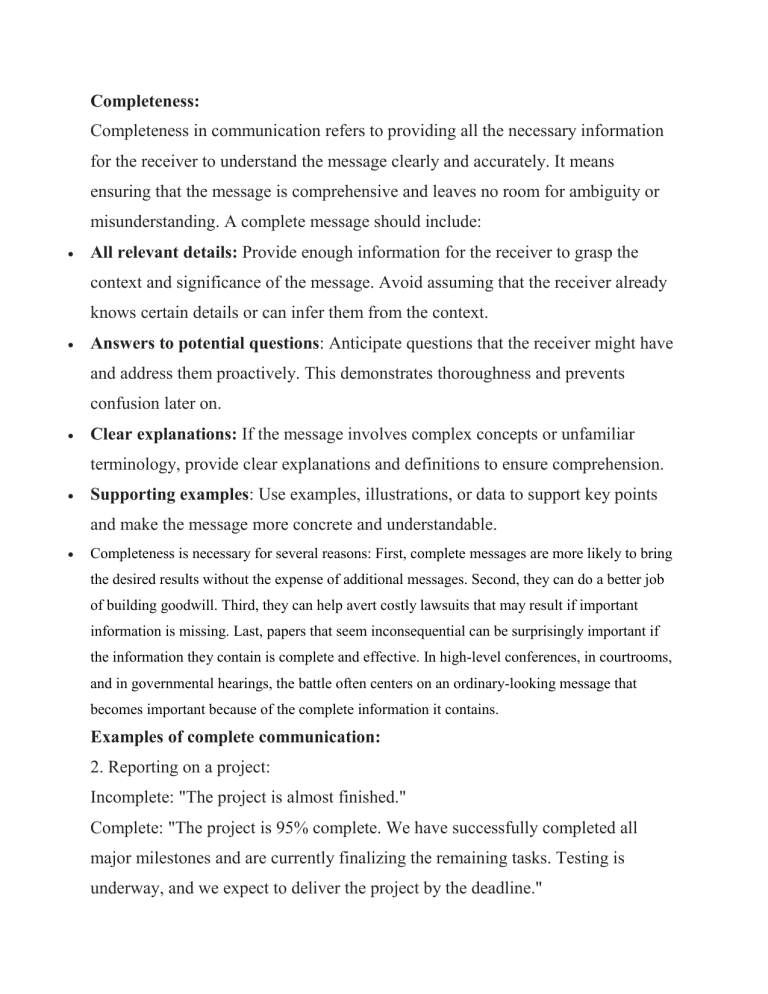
Completeness: Completeness in communication refers to providing all the necessary information for the receiver to understand the message clearly and accurately. It means ensuring that the message is comprehensive and leaves no room for ambiguity or misunderstanding. A complete message should include: All relevant details: Provide enough information for the receiver to grasp the context and significance of the message. Avoid assuming that the receiver already knows certain details or can infer them from the context. Answers to potential questions: Anticipate questions that the receiver might have and address them proactively. This demonstrates thoroughness and prevents confusion later on. Clear explanations: If the message involves complex concepts or unfamiliar terminology, provide clear explanations and definitions to ensure comprehension. Supporting examples: Use examples, illustrations, or data to support key points and make the message more concrete and understandable. Completeness is necessary for several reasons: First, complete messages are more likely to bring the desired results without the expense of additional messages. Second, they can do a better job of building goodwill. Third, they can help avert costly lawsuits that may result if important information is missing. Last, papers that seem inconsequential can be surprisingly important if the information they contain is complete and effective. In high-level conferences, in courtrooms, and in governmental hearings, the battle often centers on an ordinary-looking message that becomes important because of the complete information it contains. Examples of complete communication: 2. Reporting on a project: Incomplete: "The project is almost finished." Complete: "The project is 95% complete. We have successfully completed all major milestones and are currently finalizing the remaining tasks. Testing is underway, and we expect to deliver the project by the deadline." 3. Giving feedback on a performance: Incomplete: "You did a good job." Complete: "Your presentation was clear, concise, and well-organized. You effectively communicated the key points and engaged the audience. However, I would suggest improving your slide design and incorporating more visuals to enhance the presentation's impact." By striving for completeness in communication, you can ensure that your messages are understood clearly and accurately, leading to better collaboration, decisionmaking, and overall communication effectiveness. CONCISENESS Conciseness is the ability to convey information in as few words as possible without sacrificing clarity or accuracy. It is about getting to the point quickly and efficiently, without wasting the reader's or listener's time. Why is conciseness important? Conciseness is important for several reasons: It makes your communication more effective. When you are concise, your message is easier to understand and remember. This is because your audience is not overloaded with unnecessary information. It makes you sound more credible. Concise communication shows that you are organized and thoughtful, and that you have a clear understanding of your message. It saves time. Both you and your audience will save time when you are concise. You will spend less time writing or speaking, and your audience will spend less time reading or listening. How to be concise Here are some tips for being more concise in your communication: Eliminate unnecessary words. This includes things like filler words (e.g., "like," "um," "you know"), vague words (e.g., "thing," "stuff," "problem"), and jargon. Use single-word substitutes instead of phrases whenever possible without changing meanings . Use active voice instead of passive voice. Active voice is clearer and more concise. Be specific. Include only relevant statements. When you are specific, you give your audience the information they need without making them guess or fill in the blanks. Use strong verbs. use a verb in the present tense Verbs are the workhorses of a sentence, so make sure you are using strong ones that carry your meaning. Organize your thoughts. Before you start writing or speaking, take some time to organize your thoughts. This will help you to avoid rambling and repeating yourself. Avoid unnecessary' repetition. Sometimes repetition is necessary for emphasis. But when the same thing is said two or three times without reason, the message becomes wordv and boring. Use a shorter name after you ha\e mentioned the long one once: Instead of the "Thompson Product Manufacturing Company,'' "Thompson Company." 2. Use pronouns or initials rather than repeat long names: Instead of citing "North Central Auto Insurance Company, Inc.'' again and again, use "it" or "they" or "NCAI." 3. Cut out all needless repetition of phrases and sentences. For example, the following letter from a business executive to a firm the company had dealt with for five years shows unnecessary repetition at its worst: Examples of conciseness Here are some examples of how to make your communication more concise: Instead of: "I believe that we should consider the possibility of implementing a new strategy." Say: "Let's implement a new strategy." Instead of: "The problem is that we are not getting enough traffic to our website." Say: "Our website traffic is low." Instead of: "I think that the new product is going to be a big success." Say: "I'm confident that the new product will be successful." Consideration , consideration refers to the ability to tailor your message to the needs and perspectives of your audience. It involves putting yourself in their shoes and understanding their point of view before you start communicating. When you are considerate, you are more likely to be understood, respected, and persuasive. Here are some of the key aspects of consideration in communication: Empathy: Empathy is the ability to understand and share the feelings of others. When you are empathetic, you are better able to see things from your audience's perspective and communicate in a way that is sensitive to their needs. Respect: Respect involves valuing the thoughts, feelings, and beliefs of others. When you are respectful, you are less likely to make assumptions or judgments about your audience. Audience awareness: Audience awareness is the ability to understand the characteristics and needs of your audience. When you are aware of your audience, you can tailor your message to their level of understanding, their interests, and their cultural background. Here are some examples of how to demonstrate consideration in your communication: Use "you" language instead of "I" and "we.": When you use "you" language, you focus on the needs and perspectives of your audience. For example, instead of saying, We welcome you to Bekinson's. If we can be of additional service in any manner, please call on us . say You are always welcome at Bekinson's. Please call on us whenever you need additional services. Be mindful of nonverbal cues: Nonverbal cues, such as tone of voice, facial expressions, and body language, can convey a lot of information about your attitude and intentions. When you are communicating with someone in person, be mindful of your nonverbal cues and make sure they are consistent with your message. Apply Integrity and Ethics To be trulv considerate, you need also to apply integrity—high moral standards, personal honor, truthfulness, sincerity—to your written and oral messages. Integrity is indispensable in our jobs, in business transactions, in social and political acthities. in eveivthing we do. Without it, business communications would prove worthless, and our confidence in people would be shattered. Ethics is concerned with what is right human conduct. Codes of ethics proxide standards enabling us to determine the fundamental distinction between right and wrong human behaxior. Show Reader Benefit or Interest in Reader: Whenever possible and true, show how your readers will benefit from whatever the message asks or announces. They will be more likely to react favorablv and do what vou suggest if you show that benefits are worth the effort and cost. In situations where actual direct reader benefit is impossible or irrelevant to the subject matter, the message should at least show interest in and concern for the reader s needs or viewpoint. Even a simple request gets better response when a reader-benefit plug accompanies it. You will be glad to know that we now have a Walk-Up Window open 7-1 a.m. and 3-8 p.m. every weekday. Some readers may wonder, "So what?" The revised sentence includes reader benefit: You can now take care of your banking needs also at our new Walk-Up Window. It is open with a capable teller to serve you 7-1 a.m. and 3-8 p.m. Monday through Friday. Emphasize the Positive, Pleasant Facts :A third way to show consideration for your reader (or listener) is to accent the positive. This means (1) stressing what can be done instead of what cannot be done and (2) focusing on words your recipient can consider favorably. Negative-Unpleasant It is impossible to open an account for you today. Positive—Pleasant As soon as your signature card reaches us, we will gladly open an account for you. Concreteness Concreteness is one of the seven C's of effective communication. It refers to the use of specific, vivid language that paints a clear picture in the listener's mind. Concrete communication is the opposite of vague and abstract communication. When we communicate concretely, we use sensory details, examples, and data to support our ideas. This makes our communication more engaging and easier to understand. Why is Concreteness Important? There are several reasons why concreteness is important in communication: Clarity: Concrete communication reduces the risk of misunderstandings, as it leaves less room for interpretation. Engagement: Concrete language is more engaging and interesting to listen to, as it helps the listener to visualize what is being said. Persuasiveness: Concrete communication is more persuasive, as it provides evidence and support for the speaker's claims. Examples of Concrete Communication Here are some examples of concrete communication: Instead of saying "the product is efficient," say "the product can save you up to 20% on your energy bill." Instead of saying "the employee is hard-working," say "the employee increased sales by 15% in the last quarter." How to Be More Concrete in Your Communication Here are some tips for being more concrete in your communication: Use specific facts and figures. Put action in your verbs. Choose vivid, imagebuilding words. Use Specific Facts and Figures Whenever you can, substitute an exact statement or a figure for a general word to make your message more concrete and convincing. Vague, General, Indefinite ‘Our product has won several prizes . Concrete and Convincing’ [Name] Our product has won first prize in four national contests within the past three years . Put Action in Your Verbs Strong verbs can activate other words and help make your sentences definite. To compose strong sentences, you should (1) use active rather than passive verbs and (2) put action in your verbs instead of in nouns or infinitives. Passive (Subject Receives the) Action) Tests were made by us. Active (Subject Performs the Action We made tests [or Tests showed that . . .]. Action Hiding in a "Quiet Noun" We will take a look at your record. Action in the Verb We will look at your record, Choose Vivid, Image-Building Words Among the devices vou can use to make your messages forceful, vivid, and specific are comparisons, figurative language, concrete instead of abstract nouns, and well-chosen adjectives and adverbs. Clarity in Communication Clarity is one of the Seven C's of effective communication. It is the foundation of all good communication, and without it, our messages can easily be misunderstood or misinterpreted. Clarity means expressing your thoughts and ideas in a way that is clear, concise, and easy to understand. It involves using simple language, avoiding jargon, and organizing your thoughts in a logical manner. Why is Clarity Important? Clarity is important in communication for several reasons: 1. Reduces Misunderstandings: When we communicate clearly, there is less room for interpretation and miscommunication. This can help to avoid conflict, build trust, and ensure that our messages are understood. 2. Enhances Engagement: Clear communication is more engaging and interesting to listen to. When we use simple language and avoid unnecessary details, our audience is more likely to pay attention and retain our message. 3. Promotes Persuasiveness: Clear communication is more persuasive. When we state our arguments in a clear and concise manner, we are more likely to convince our audience of our point of view. Examples of Clear Communication Here are some examples of clear communication: Instead of saying "the product is effective," say "the product has been shown to reduce symptoms by 50%." Instead of saying "the company is committed to sustainability," say "the company has reduced its carbon footprint by 20% in the last five years." Instead of saying "the policy is complex," say "the policy is summarized in three easy-to-understand steps." How to Be Clear in Your Communication Here are some tips for being clear in your communication: Choose Short, Familiar, Conversational Words When you have a choice between a long word and a short one, use the short, familiar word that your reader or listener will quickly understand. Also, use synonyms instead of Latin terms (L) if they, though short, mav be unfamiliar to your message receivers. show, uncover disclose for example e.g. (L) Construct Effective Sentences and Paragraphs Arranging your words in well-constructed sentences and paragraphs is also an essential task that requires adaptation to your reader. Important characteristics to consider are Length As Short As Desirable , Unity, to Express Main Ideas, Coherence, for Clear Meanings Being an excellent lawyer, I am sure you can help us. Being an excellent lawyer, you can surely help us, Emphasis, for Forceful, Clear Expression. . , . The airplane finally approached the speed of sound and it became very difficult to control. Emphasis: As it finally approached the speed of sound, the airplane became very difficult to control Include Examples, Illustrations, and Other Visual Aids, When Desirable In addition to focusing on clarity of words, sentences, and paragraphs, you can also sometimes use various visual aids effectively. When you have a complicated or lengthy explanation in a letter, speech, or report, you'll often find you can improve the clarity by giving your recipients an example, analogy, or illustration. Furthermore, visual aids—such as headings, tabulations, itemizations, pictures, charts—are definite aids to clarity and easy understanding. Also, typographical aids can be useful. Some important statements may be underlined, numbered, colored, or typed in all CAPITALS or italics or on short lines with wider margins. 1. Proofread and edit: Before sending or delivering your message, take the time to proofread and edit it for clarity and conciseness. Additional Tips for Clarity in Different Contexts In writing: Use short paragraphs, bullet points, and headings to break up your text and make it easier to read. In speaking: Speak slowly and enunciate clearly. Use pauses to emphasize important points and avoid speaking in monotone. In presentations: Use visuals, such as slides and handouts, to complement your verbal communication and make your message more engaging. Courtesy Courtesy is one of the seven C's of effective communication. It refers to showing respect and consideration for the other person in the communication process. Courtesy stems from sincere you-attitude.Courtesy is essential for building positive relationships and achieving mutual understanding. It is not merely politeness with mechanical insertions of "pleases" and "thank-you's." To be courteous, considerate communicators should follow Why is Courtesy Important? There are several reasons why courtesy is important in communication: Builds rapport: Courtesy helps to create a positive atmosphere and build rapport with the other person. This makes them more likely to listen to you and be receptive to your message. Prevents misunderstandings: Courtesy can help to prevent misunderstandings by creating a climate of open communication. When people feel respected, they are more likely to be willing to ask questions and clarify their understanding. Promotes cooperation: Courtesy can also promote cooperation and teamwork. When people feel respected and valued, they are more likely to be willing to work together to achieve common goals. Examples of Courteous Communication Here are some examples of courteous communication: Be sincerely tactful, thoughtful, and appreciative. When communicating with others, it is important to be sincere, tactful, thoughtful, and appreciative. This means being genuine in your words and actions, being mindful of the other person's feelings, considering their point of view, and expressing gratitude. Tactless, Blunt Your letter is not clear at all; I can't understand it. Tactful If I understand your letter correctly, . . Sincerity means being genuine and authentic in your communication. Avoid putting on a facade or pretending to be someone you're not. People can usually spot a fake, and it will only damage your credibility and relationships. Tact means being considerate of the other person's feelings. Be mindful of your words and avoid saying anything that could be hurtful or offensive. If you need to criticize someone, do it in a constructive and respectful way. Thoughtfulness means being considerate of the other person's needs and wants. Take the time to think about how your words and actions will affect them. Go out of your way to do things for them that will make their lives easier or more enjoyable. Appreciation means expressing gratitude for the things that others do for you. A simple "thank you" can go a long way in making someone feel appreciated. Omit expressions that irritate, hurt, or belittle. Certain words and phrases can have a negative impact on your communication. Avoid using expressions that are likely to irritate, hurt, or belittle the other person. These types of expressions can damage relationships and make it difficult to communicate effectively. Here are some examples of expressions to avoid: Insults: Insults are personal attacks that are meant to hurt the other person's feelings. Avoid using insults, even if you are angry or frustrated. Sarcasm: Sarcasm is a form of irony that is often used to mock or belittle someone. Avoid using sarcasm, as it can easily be misinterpreted and cause offense. Put-downs: Put-downs are attempts to make the other person feel inferior or unimportant. Avoid using put-downs, as they can damage the other person's selfesteem. Threats: Threats are attempts to control or intimidate the other person. Avoid using threats, as they can create a hostile environment and make it impossible to communicate effectively. Grant and apologize good-naturedly. When you make a mistake or do something wrong, it is important to admit your error and apologize sincerely. A good-natured apology can go a long way in repairing the damage and restoring the relationship. Whenever you grant a customer's request, begin your letter with the best news first and inject a courteous, ungrudging tone Here are some tips for apologizing good-naturedly: Take responsibility for your actions. Don't try to blame someone else or make excuses. Be specific about what you are apologizing for. Don't just say "I'm sorry" without explaining what you did wrong. Express genuine remorse. Show that you are truly sorry for your actions. Offer to make amends. If possible, offer to do something to repair the damage you have caused. Apologize sincerely and in a timely manner. The sooner you apologize, the better. By following these tips, you can show that you are a mature and responsible person who is willing to take accountability for your actions. Non-Courtesy: Scenario: You are in a restaurant waiting to be seated. A new group arrives and is seated before you, even though you arrived first. Non-Courteous Response: You approach the hostess and say in a loud, angry voice, "Excuse me! We were here first! How could you seat them before us?" Courteous Response: You approach the hostess politely and say, "Excuse me, we were here first. Would it be possible to seat us before the other group?" Here is an example of non-courtesy and the same example shown with courtesy: Non-Courtesy: Scenario: You are in a restaurant waiting to be seated. A new group arrives and is seated before you, even though you arrived first. Non-Courteous Response: You approach the hostess and say in a loud, angry voice, "Excuse me! We were here first! How could you seat them before us?" Courtesy: Courteous Response: You approach the hostess politely and say, "Excuse me, we were here first. Would it be possible to seat us before the other group?" As you can see, the two responses convey very different messages. The non-courteous response is accusatory and disrespectful, while the courteous response is polite and considerate. The non-courteous response is likely to make the hostess feel defensive and irritated, while the courteous response is likely to make her feel respected and appreciated. Here is another example of non-courtesy and the same example shown with courtesy: Non-Courtesy: Scenario: You are at a meeting and someone is presenting an idea that you disagree with. Non-Courteous Response: You interrupt the presenter and say, "That's a terrible idea! You don't know what you're talking about!" Courtesy: Courteous Response: You wait until the presenter is finished speaking and then say, "I appreciate your perspective on this issue. I have a different point of view that I would like to share. Correctness, one of the seven C's of effective communication, refers to the accuracy and precision of information conveyed in the communication process. It encompasses the use of proper grammar, syntax, punctuation, and vocabulary to ensure clarity and avoid misunderstandings. Why is Correctness Important in Communication? Correctness is crucial in communication for several reasons: 1. Clarity: Accurate and precise language minimizes ambiguity and ensures that the intended message is effectively conveyed. 2. Credibility: Proper use of language enhances the speaker's or writer's credibility, establishing them as a reliable source of information. 3. Professionalism: Correctness reflects professionalism and attention to detail, making a positive impression in both personal and professional settings. 4. Effective Communication: Correctness is the foundation of effective communication, allowing for clear understanding, informed decision-making, and strong relationships. Sure, here are some examples of how to use the right level of language, check the accuracy of figures, facts, and words, maintain acceptable writing mechanics, choose nondiscriminatory expressions, and apply all other pertinent C qualities in your writing: Right Level of Language Consider your audience. When writing for a general audience, use simple language and avoid jargon or technical terms. When writing for a more specialized audience, you can use more technical language, but be sure to define any terms that may not be familiar to all readers. Match the tone of the situation. In a formal setting, use more formal language. In an informal setting, you can use more casual language. Accuracy of Figures, Facts, and Words Double-check your facts. Before you submit your writing, take the time to double-check all of your facts and figures. You can do this by consulting reputable sources, such as government websites, academic journals, or well-known news organizations. Use precise language. Be as specific as possible in your writing. Avoid using vague language or generalizations. Proofread carefully. Proofread your writing carefully to catch any errors in spelling, grammar, or punctuation. Acceptable Writing Mechanics Acceptable writing mechanics include correct punctuation, capitalization, syllabication, and spelling— plus correct sentence and paragraph structure. This area also includes using correct format for letters, memos, reports, and envelopes Careless Omissions Another way to maintain correct writing mechanics is to double-check for anv careless omissions of punctuation marks or words needed for grammatical accuracy. Use proper grammar and punctuation. This includes using the correct verb tenses, subject-verb agreement, and punctuation marks. Format your writing correctly. Use proper indentation, spacing, and margins. Use a consistent style. Choose a style guide, such as APA or MLA, and follow its guidelines consistently throughout your writing. Nondiscriminatory Expressions Avoid using stereotypes or generalizations. Don't make assumptions about people based on their race, gender, religion, sexual orientation, or any other personal characteristic. Use gender-neutral language. When referring to people in general, use gender-neutral terms such as "person," "individual," or "human being." Avoid using offensive or insensitive language. Be mindful of the words you use and avoid using language that could be hurtful or offensive to anyone. Applying Other Pertinent C Qualities Clarity: Be clear and concise in your writing. Avoid using jargon or technical terms that your audience may not understand. Completeness: Provide all of the information that your audience needs to understand your message. Conciseness: Get to the point quickly and avoid unnecessary words or phrases. Consideration: Be considerate of your audience's needs and interests. Concreteness: Use specific examples and data to support your claims. Courtesy: Be polite and respectful in your writing. Credibility: Be credible and trustworthy by supporting your claims with evidence and using reliable sources. By following these guidelines, you can write effectively and communicate your message in a clear, concise, and accurate way. Non-Correctness: Scenario: You are writing a job application letter. You use a lot of slang and informal language. You also make several grammatical errors.** Example: "I'm a super qualified candidate for this position. I'm a total go-getter and a team player. I'm also a great communicator and I'm always up for a challenge." Correctness: Scenario: You are writing a job application letter. You use formal language and avoid slang. You also proofread your letter carefully to ensure that there are no grammatical errors.** Example: "I am writing to express my keen interest in the position of [position name] at [company name]. With my strong academic background and relevant work experience, I am confident that I possess the skills and qualifications necessary to excel in this role." The two examples differ in terms of formality and professionalism. The non-correct example is written in a very informal style, using slang and colloquial language. This may not make a good impression on the employer. The correct example is written in a more formal style, using standard English and avoiding slang. This shows the employer that you are a professional and that you take the job application seriously.
